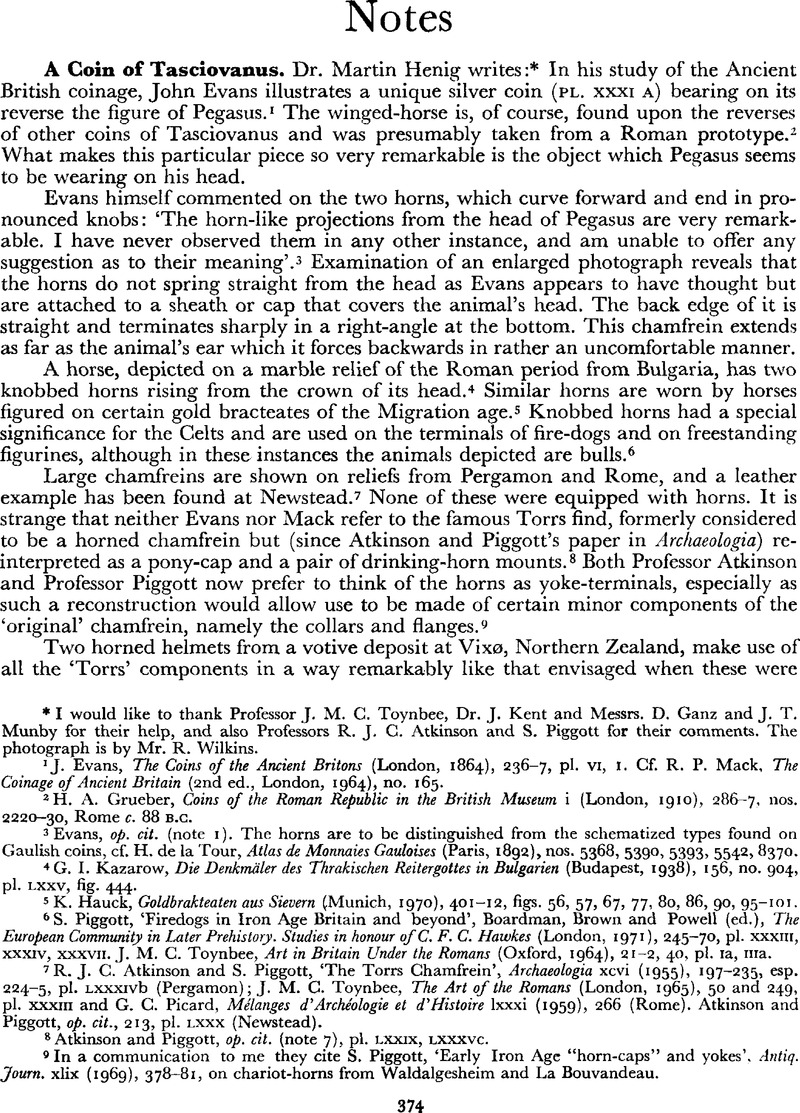Published online by Cambridge University Press: 09 November 2011

1 Evans, J., The Coins of the Ancient Britons (London, 1864), 236–7Google Scholar, pl. vi, 1. Cf. Mack, R. P., The Coinage of Ancient Britain (2nd ed., London, 1964), no. 165.Google Scholar
2 Grueber, H. A., Coins of the Roman Republic in the British Museum i (London, 1910), 286–7Google Scholar, nos. 2220-30, Rome c. 88 B.C.
3 Evans, op. cit. (note I). The horns are to be distinguished from the schematized types found on Gaulish coins, cf. Tour, H. de la, Atlas de Monnaies Gauloises (Paris, 1892), nos. 5368, 5390, 5393, 5542, 8370.Google Scholar
4 Kazarow, G. I., Die Denkmäler des Thrakischen Reitergottes in Bulgarien (Budapest, 1938), 156, no. 904, pl. LXXV, fig. 444.Google Scholar
5 Hauck, K., Goldbrakteaten aus Sievern (Munich, 1970), 401–12Google Scholar, figs. 56, 57, 67, 77, 80, 86, 90, 95-101.
6 Piggott, S., ‘Firedogs in Iron Age Britain and beyond’, Boardman, , Brown, and Powell, (ed.), The European Community in Later Prehistory. Studies in honour of C. F. C. Hawkes (London, 1971), 245–70Google Scholar, pl. xxxm, xxxiv, xxxvii. Toynbee, J. M. C., Art in Britain Under the Romans (Oxford, 1964), 21–2, 40, pl. Ia, IIIaGoogle Scholar.
7 Atkinson, R. J. C. and Piggott, S., ‘The Torrs Chamfrein’, Archaeologia xcvi (1955), 197–235CrossRefGoogle Scholar, esp. 224-5, pl. Lxxxivb (Pergamon); Toynbee, J. M. C., The Art of the Romans (London, 1965), 50 and 249Google Scholar, pl. XXXIII and Picard, G. C., Mélanges d'Archéologie et d'Histoire lxxxi (1959), 266 (Rome)Google Scholar. Atkinson and Piggott, op. cit., 213, pl. LXXX (Newstead).
8 Atkinson and Piggott, op. cit. (note 7), pl. LXXIX, LXXXVC.
9 In a communication to me they cite Piggott, S., ‘Early Iron Age “horn-caps” and yokes’, Antiq. Journ. xlix (1969), 378–81CrossRefGoogle Scholar, on chariot-horns from Waldalgesheim and La Bouvandeau.
10 Hencken, H., The Earliest European Helmets (Cambridge, Mass., 1971), 169–74Google Scholar. They are somewhat earlier than the Torrs metalwork, belonging it is believed to Northern Bronze Age 4 (c. eleventh to eighth century B.C.). For other horned helmets, Megaw, J. V. S., Art of the European Iron Age (Bath, 1970), 170Google Scholar, no. 294 (Waterloo). Mattingly, H., Coins of the Roman Empire in the British Museum i (London, 1923), 52Google Scholar, nos. 280-2, pl. v, 4, 5, coin of P. Carisius minted at Emerita c. 25/23 B.C. See also Klindt-Jensen, O., Antiquity xxxiii (1959), 163Google Scholar f. and pl. XVIII (f) for a helmet on the Gundestrup cauldron; he mentions horns from Waldalgesheim (Jacobsthal, P., Early Celtic Art (Oxford, 1944), no. 156a, pl. 96Google Scholar) which ‘presumably were mounted on a helmet; they are reminiscent of the horns on the sell-known Vixø helmets which may be their prototypes’. Horned helmets are depicted on the Arch at Orange (R. Amy, P.-M. Duval, etc., L'Arc d'Orange (XVe supp. to Gallia, Paris, 1962), 84Google Scholar and pl. XLIII, He) and on the Mausoleum of the Julii at Glanum, where an example is shown with knobbed terminals (H. Rolland, Le Mausolée deGlanum (XXIe supp. to Gallia, Paris, 1969), 62Google Scholar, no. c, pl. xxix, N 1).
11 Atkinson and Piggott, op. cit. (note 7), 202, 204.
12 Allen, D., PPS xxiv (1958), 43–63.Google Scholar